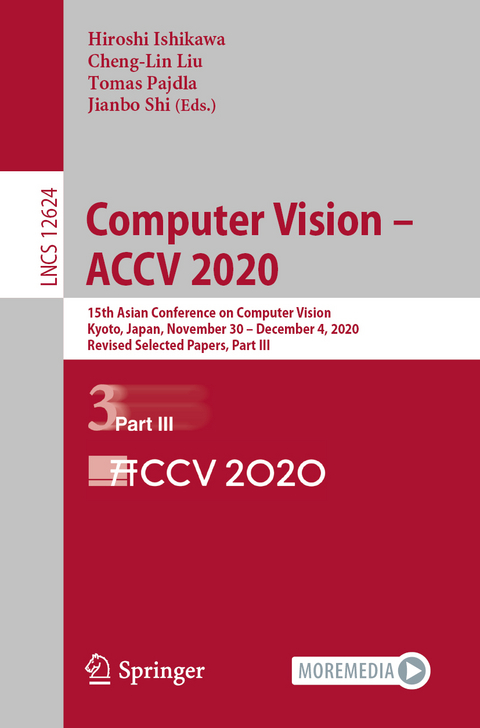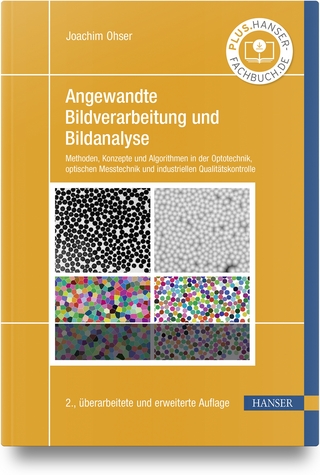
Computer Vision – ACCV 2020
Springer International Publishing (Verlag)
978-3-030-69534-7 (ISBN)
The total of 254 contributions was carefully reviewed and selected from 768 submissions during two rounds of reviewing and improvement. The papers focus on the following topics:
Part I: 3D computer vision; segmentation and grouping
Part II: low-level vision, image processing; motion and tracking
Part III: recognition and detection; optimization, statistical methods, and learning; robot vision
Part IV: deep learning for computer vision, generative models for computer visionPart V: face, pose, action, and gesture; video analysis and event recognition; biomedical image analysis
Part VI: applications of computer vision; vision for X; datasets and performance analysis
*The conference was held virtually.
Recognition and Detection.- End-to-end Model-based Gait Recognition.- Horizontal Flipping Assisted Disentangled Feature Learning for Semi-Supervised Person Re-Identification.- MIX'EM: Unsupervised Image Classification using a Mixture of Embeddings.- Backbone Based Feature Enhancement for Object Detection.- Long-Term Cloth-Changing Person Re-identification.- Any-Shot Object Detection.- Background Learnable Cascade for Zero-Shot Object Detection.- Unsupervised Domain Adaptive Object Detection using Forward-Backward Cyclic Adaptation.- COG: COnsistent data auGmentation for object perception.- Synthesizing the Unseen for Zero-shot Object Detection.- Fully Supervised and Guided Distillation for One-Stage Detectors.- Visualizing Color-wise Saliency of Black-Box Image Classification Models.- ERIC: Extracting Relations Inferred from Convolutions.- D2D: Keypoint Extraction with Describe to Detect Approach.- Accurate Arbitrary-Shaped Scene Text Detection via Iterative Polynomial ParameterRegression.- Adaptive Spotting: Deep Reinforcement Object Search in 3D Point Clouds.- Efficient Large-Scale Semantic Visual Localization in 2D Maps.- Synthetic-to-Real Unsupervised Domain Adaptation for Scene Text Detection in the Wild.- Scale-Aware Polar Representation for Arbitrarily-Shaped Text Detection.- Branch Interaction Network for Person Re-identification.- BLT: Balancing Long-Tailed Datasets with Adversarially-Perturbed Images.- Jointly Discriminating and Frequent Visual Representation Mining.- Discrete Spatial Importance-Based Deep Weighted Hashing.- Low-level Sensor Fusion Network for 3D Vehicle Detection using Radar Range-Azimuth Heatmap and Monocular Image.- MLIFeat: Multi-level information fusion based deep local features.- CLASS: Cross-Level Attention and Supervision for Salient Objects Detection.- Cascaded Transposed Long-range Convolutions for Monocular Depth Estimation.- Optimization, Statistical Methods, and Learning.- Bridging Adversarial and Statistical Domain Transfer via Spectral Adaptation Networks.- Large-Scale Cross-Domain Few-Shot Learning.- Channel Pruning for Accelerating Convolutional Neural Networks via Wasserstein Metric.- Progressive Batching for Efficient Non-linear Least Squares.- Fast and Differentiable Message Passing on Pairwise Markov Random Fields.- A Calibration Method for the Generalized Imaging Model with Uncertain Calibration Target Coordinates.- Graph-based Heuristic Search for Module Selection Procedure in Neural Module Network.- Towards Fast and Robust Adversarial Training for Image Classification.- Few-Shot Zero-Shot Learning: Knowledge Transfer with Less Supervision.- Lossless Image Compression Using a Multi-Scale Progressive Statistical Model.- Spatial Class Distribution Shift in Unsupervised Domain Adaptation: Local Alignment Comes to Rescue.- Robot Vision.- Point Proposal based Instance Segmentation with Rectangular Masks for Robot Picking Task.- Multi-task Learning with Future States for Vision-based Autonomous Driving.- MTNAS: Search Multi-Task Networks for Autonomous Driving.- Compact and Fast Underwater Segmentation Network for Autonomous Underwater Vehicles.- L2R GAN: LiDAR-to-Radar Translation.- V2A - Vision to Action: Learning robotic arm actions based on vision and language.- To Filter Prune, or to Layer Prune, That Is The Question.
| Erscheinungsdatum | 01.03.2021 |
|---|---|
| Reihe/Serie | Image Processing, Computer Vision, Pattern Recognition, and Graphics | Lecture Notes in Computer Science |
| Zusatzinfo | XVIII, 757 p. 245 illus., 229 illus. in color. |
| Verlagsort | Cham |
| Sprache | englisch |
| Maße | 155 x 235 mm |
| Gewicht | 1169 g |
| Themenwelt | Informatik ► Grafik / Design ► Digitale Bildverarbeitung |
| Informatik ► Theorie / Studium ► Künstliche Intelligenz / Robotik | |
| Informatik ► Weitere Themen ► Hardware | |
| Schlagworte | Applications • Artificial Intelligence • biomedical image analysis • Computer Networks • Computer Science • computer vision • conference proceedings • Databases • Image Processing • image reconstruction • Image Segmentation • Imaging Systems • Informatics • machine learning • Network Protocols • Neural networks • Object detection • Object recognition • pattern recognition • Research • Semantics • Signal Processing |
| ISBN-10 | 3-030-69534-4 / 3030695344 |
| ISBN-13 | 978-3-030-69534-7 / 9783030695347 |
| Zustand | Neuware |
| Haben Sie eine Frage zum Produkt? |
aus dem Bereich


